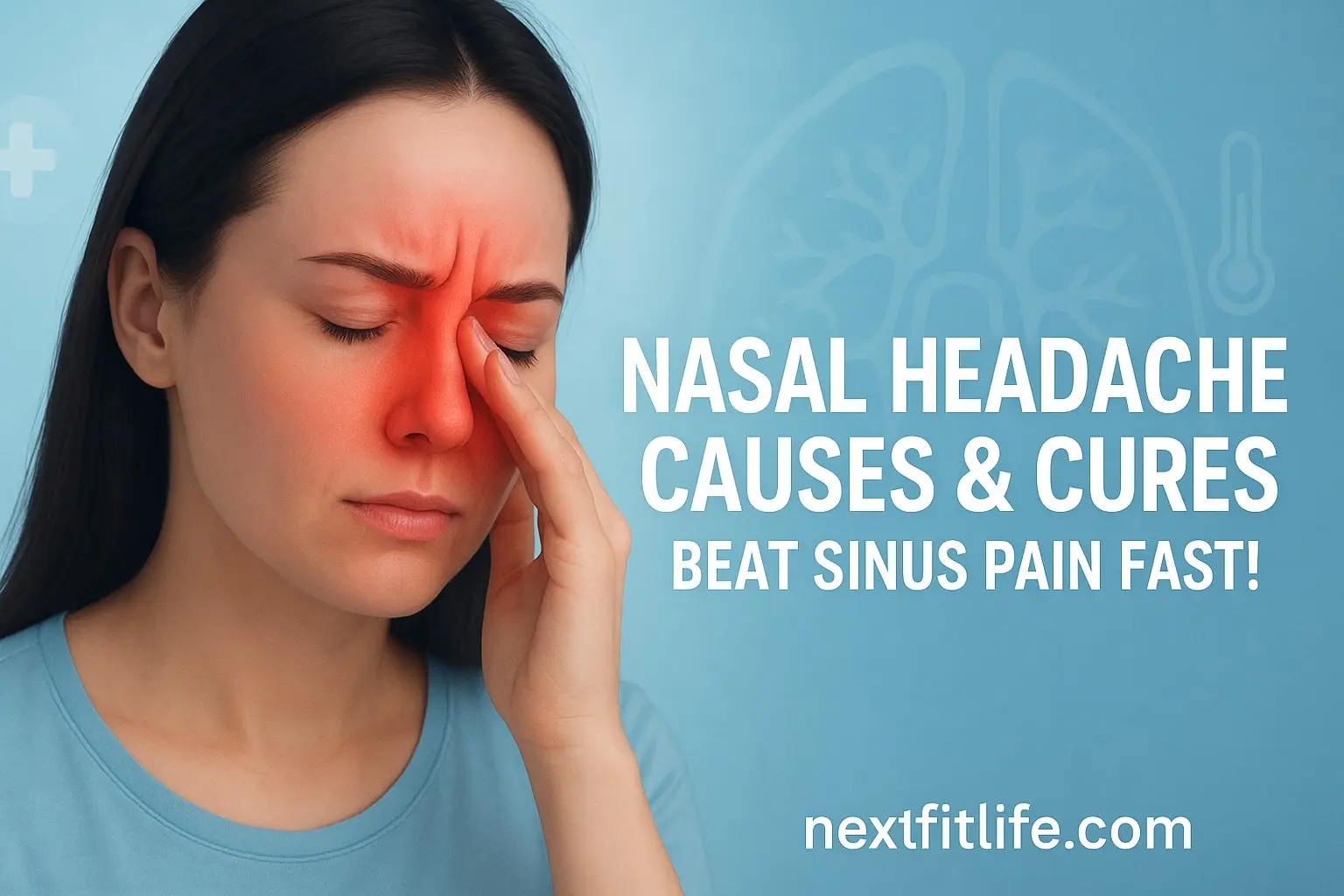Nasal headache is that uncomfortable pain and pressure you feel around your nose, forehead, and cheeks. It happens when your nasal passages get blocked or swollen. The good news? You can fix it with simple home remedies and treatments that work fast.
This guide shows you exactly how to beat that pain and breathe easily again.
What Is a Nasal Headache?
A sinus pressure headache feels like heavy pressure pushing against your face. You might feel it behind your nose, across your forehead, or around your eyes. Some people say it feels like their head is stuffed with cotton.
Here’s what you need to know: This type of headache happens when something blocks your nasal passages. Your sinuses can’t drain properly, and pressure builds up. That pressure causes pain.
Key Fact Box:
- Nasal headaches affect millions of people every year
- They feel different from regular headaches because they come with nasal congestion
- The pain usually gets worse when you bend forward
- According to the Mayo Clinic, many people think they have sinus headache symptoms when they have migraines
Common Causes of Nasal Headache
Understanding what triggers your headache behind the nose helps you treat it better. Here are the major causes:
Sinus Infections
A sinus infection headache happens when bacteria or viruses make your sinuses swell up. Your nose produces thick, colored mucus. The pressure builds fast, and boom, you’ve got a pounding headache.
I have seen many people mistake a cold for a sinus infection. The difference? Sinus infections last longer and cause facial pain and pressure that won’t quit.
Allergies
Nasal congestion and headache often come together during allergy season. When pollen, dust, or pet dander irritate your nose, your body produces extra mucus. This blocks your senses and creates that awful pressure feeling.
Blocked Nasal Passages
Sometimes your nose just gets blocked. A blocked nose headache relief becomes necessary when:
- You caught a cold
- The air is too dry
- You’re exposed to smoke or strong chemicals
- You have a deviated septum (a crooked wall inside your nose)
Weather Changes
Quick weather changes cause sinus pressure headaches for many people. When air pressure drops before a storm, it affects the pressure inside your sinuses. This creates pain that can last for hours.
Chronic Rhinosinusitis
This is a fancy term for long-lasting sinus inflammation. Chronic rhinosinusitis pain sticks around for 12 weeks or more. It causes constant nasal congestion and headaches, which make daily life difficult.
Nasal Headache Symptoms You Shouldn’t Ignore
How do you know if you have a real Sinus infection headache? Watch for these signs:
Primary Symptoms:
- Sinus congestion, pain across your forehead and cheeks
- Thick, yellow or green nasal discharge
- Reduced sense of smell
- Facial pain from sinus pressure that gets worse when you lean forward
- Feeling of fullness in your ears
- Tiredness and body aches
Where You’ll Feel It:
- Frontal sinus headache: Pain across your forehead
- Ethmoid sinus headache: Pain between and behind your eyes
- Upper teeth aching (yes, really!)
Warning Signs – See a Doctor If:
- Your fever goes above 102°F
- Pain lasts more than a week
- Symptoms get worse after better
- You have vision changes
- Your neck feels stiff
Migraine vs Sinus Headache: Know the Difference
Here’s something important: migraine vs sinus headache confusion happens all the time. According to WebMD, about 90% of people who think they have sinus headaches actually have migraines.
How to Tell Them Apart
Sinus Headache:
- Comes with thick, colored mucus
- You just had a cold
- No nausea
- Your sense of smell is weak
- The last several days
Migraine:
- Clear nasal drainage
- Nausea and vomiting
- Light and noise sensitivity
- Throbbing pain on one side
- It lasts for hours to two days
I like this comparison because it saves people from taking the wrong medicine. If you have nasal obstruction symptoms plus these other signs, you’re dealing with a true sinus problem.
Fast Relief: How to Stop Nasal Headache Now
Want quick relief? These methods work fast:
Immediate Relief Techniques
- Warm Compress: Place a warm, damp cloth over your face for 10-15 minutes. The heat helps open your sinuses and reduces frontal sinus pain immediately.
- Steam Inhalation: Lean over a bowl of hot water with a towel over your head. Breathe deeply for 10 minutes. This loosens mucus and eases sinus pressure headaches fast.
- Saline Rinse: Use a neti pot or saline spray. This washes out mucus and irritants. I have tested this method many times, and it works within minutes for blocked nose headache relief.
- Stay Hydrated: Drink water, herbal tea, or warm soup. Fluids thin your muscles, making it easier to drain. This reduces pressure naturally.
- Pressure Point Massage: Gently massage these spots:
- Between your eyebrows
- The sides of your nose bridge
- Under your cheekbones
Use small circles for 30 seconds each spot. This relieves facial pain and pressure quickly.
- Elevate Your Head. Sleep with two pillows. This helps mucus drain while you rest and prevents morning nasal congestion and headache.
Medical Treatments for Stubborn Cases
Sometimes, home remedies aren’t enough. Here are sinus headache treatment options that doctors recommend:
Over-the-Counter Options
Decongestants:
- Reduce swelling in the nasal passages
- Provide sinus infection headache relief within 30 minutes
- Don’t use longer than 3 days (they can make things worse)
Pain Relievers:
- Ibuprofen or acetaminophen reduces pain
- Take with food to protect your stomach
- Follow package directions carefully
Antihistamines:
- Block allergic reactions
- Dry up excess mucus
- Help with allergy-related nasal congestion and headache
When You Need Antibiotics
Your doctor might prescribe antibiotics if:
- You have thick, colored discharge for over 10 days
- Symptoms get worse after 5-7 days
- You have a high fever with facial pain
Important: Antibiotics only work for bacterial infections. They won’t help viral infections or allergies.
Advanced Treatments
For chronic rhinosinusitis pain that won’t go away:
- Corticosteroid sprays: Reduce inflammation long-term
- Allergy shots: Build tolerance to triggers
- Surgery: Fixes structural problems like polyps or a deviated septum
Prevention: Stop Nasal Headaches Before They Start
Prevention beats treatment every time. Here’s how to avoid nasal sinus pain treatment altogether:
Daily Habits That Help
- Use a Humidifier. Keep indoor air moist, especially in winter. Dry air irritates your nasal passages and triggers sinus congestion and pain.
- Avoid Triggers: Stay away from:
- Cigarette smoke
- Strong perfumes
- Cleaning chemical fumes
- Know allergens
- Practice Good Hygiene
- Wash hands frequently
- Don’t touch your face
- Clean humidifiers weekly
- Replace air filters monthly
- Exercise Regularly. Physical activity improves circulation and helps your immune system fight infections. Even 30 minutes of walking helps prevent sinus infection headaches.
- Manage Allergies
- Take allergy medicine before symptoms start
- Keep windows closed during high pollen days
- Shower after being outdoors
- Use allergen-proof pillow covers
Natural Remedies That Really Work
Many people prefer natural solutions. These have proven benefits:
Herbal Helpers
Eucalyptus Oil: Add 3 drops to hot water and inhale. It opens airways and reduces headaches behind the nose naturally.
Ginger Tea: This anti-inflammatory powerhouse eases swelling. Drink 2-3 cups daily when you feel a sinus pressure headache coming on.
Apple Cider Vinegar: Mix 2 tablespoons in warm water with honey. It thins mucus and boosts immunity.
Foods That Fight Inflammation
Eat these to reduce nasal headache frequency:
- Spicy foods (cayenne pepper, horseradish)
- Pineapple (contains bromelain)
- Garlic and onions (natural decongestants)
- Omega-3-rich fish
- Leafy green vegetables
When to See a Doctor About Nasal Obstruction Symptoms
Don’t wait too long to get help. See a doctor if:
- Nasal headache lasts more than 10 days
- You get them frequently (more than 3 times per year)
- Home remedies don’t work after a week
- You have severe facial pain with fever
- Your vision blurs or you feel confused
An ENT specialist can examine your sinuses with special cameras. They’ll find exactly what’s causing your facial pain and pressure and create a treatment plan that works.
Key Takeaways
Let’s recap everything you need to remember about a nasal headache:
✓ Nasal headaches come from blocked sinuses, causing pressure and pain
✓ Common causes include infections, allergies, and structural problems
✓ Quick relief methods: warm compress, steam, saline rinse, hydration
✓ Most sinus headache symptoms can be treated at home
✓ The migraine vs sinus headache difference matters for correct treatment
✓ Prevention includes humidifiers, avoiding triggers, and managing allergies
✓ See a doctor if symptoms last over 10 days or get worse
✓ Natural remedies like eucalyptus oil and ginger tea provide real relief
FAQs About Nasal Headache
How to get rid of sinus headaches?
Start with simple home remedies for fast blocked nose headache relief:
- Apply warm compresses to your face for 15 minutes
- Inhale steam from hot water or a hot shower
- Use a saline nasal spray or a neti pot
- Drink plenty of fluids to thin mucus
- Take over-the-counter pain relievers
If these don’t work within 7 days, see your doctor. You might need antibiotics for a bacterial infection or prescription steroid sprays for chronic rhinosinusitis pain.
What does a nasal headache mean?
A sinus infection headache means your sinuses are blocked or inflamed. This creates pressure that causes pain in your face, forehead, and around your nose. It signals that your nasal passages can’t drain properly. Frequent culprits are the common cold, allergy flare-ups, and sinus-related infections. The pain usually comes with nasal congestion and sometimes thick mucus.
What does it mean when a headache is in your nose?
When you feel a headache behind the nose, it typically means inflammation in your nasal passages or sinuses. The pain comes from pressure buildup when mucus can’t drain. This happens with:
- Sinus infections
- Severe allergies
- Nasal polyps
- Deviated septum
The good news? This type of frontal sinus pain responds well to steam, saline rinses, and staying hydrated.
What can be mistaken for a sinus headache?
Many conditions feel like sinus headache symptoms, but they aren’t. The most common is migraine. About 90% of self-diagnosed sinus headaches are migraines, according to research published by the American Migraine Foundation.
Other conditions mistaken for sinus headaches:
- Tension headaches (from stress and muscle tightness)
- Cluster headaches (severe pain around one eye)
- Dental problems (tooth infections cause facial pain and pressure)
- TMJ disorders (jaw problems that radiate to the face)
If your nasal congestion headache comes with nausea, light sensitivity, or throbbing pain on one side, it’s probably a migraine. See a neurologist for proper diagnosis and sinus headache treatment options that work.
Conclusion
Nasal headache doesn’t have to control your life. Now you know what causes that painful pressure and exactly how to fix it. Start with simple home remedies like steam and saline rinses. Stay hydrated. Use warm compresses. These work for most people within days.
Remember the difference between sinus infection headache relief and migraine symptoms. This knowledge helps you choose the right treatment fast. Don’t suffer in silence—if home care doesn’t work after a week, see your doctor. They have powerful treatments that can end your nasal sinus pain for good.
Take control today. Try these methods and breathe easily again. Your comfortable, pain-free life is just a few steps away.



